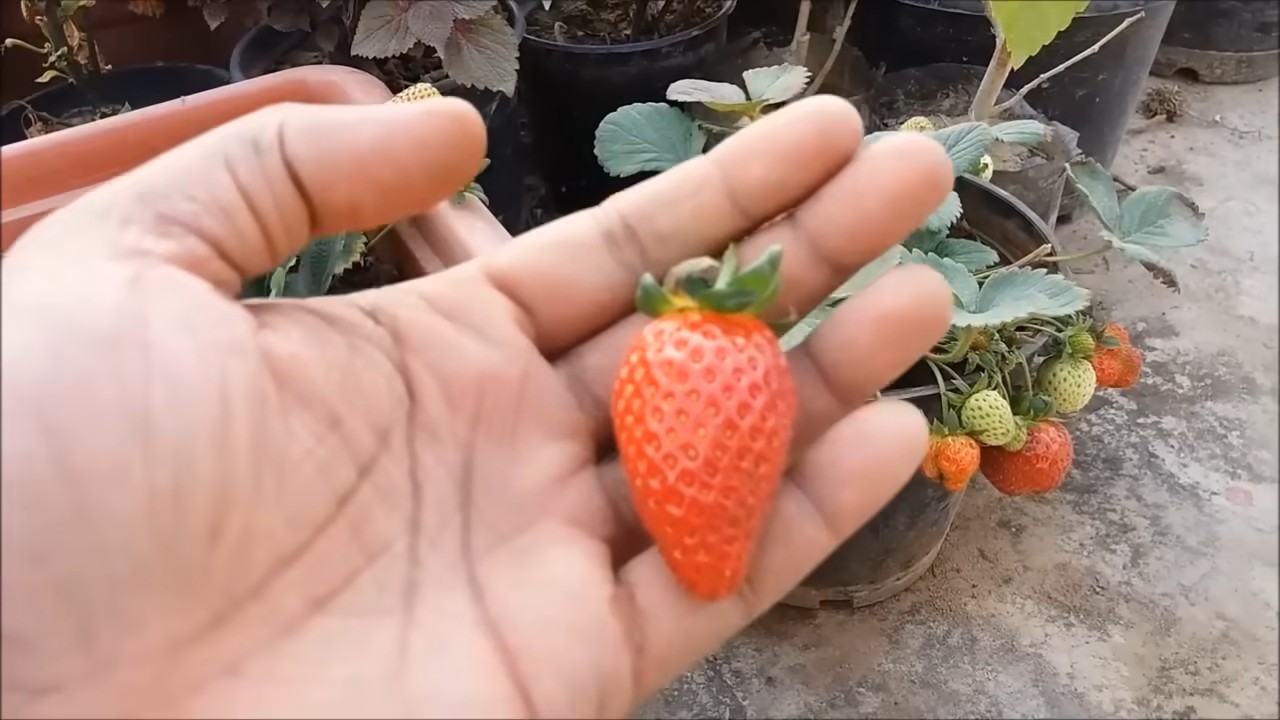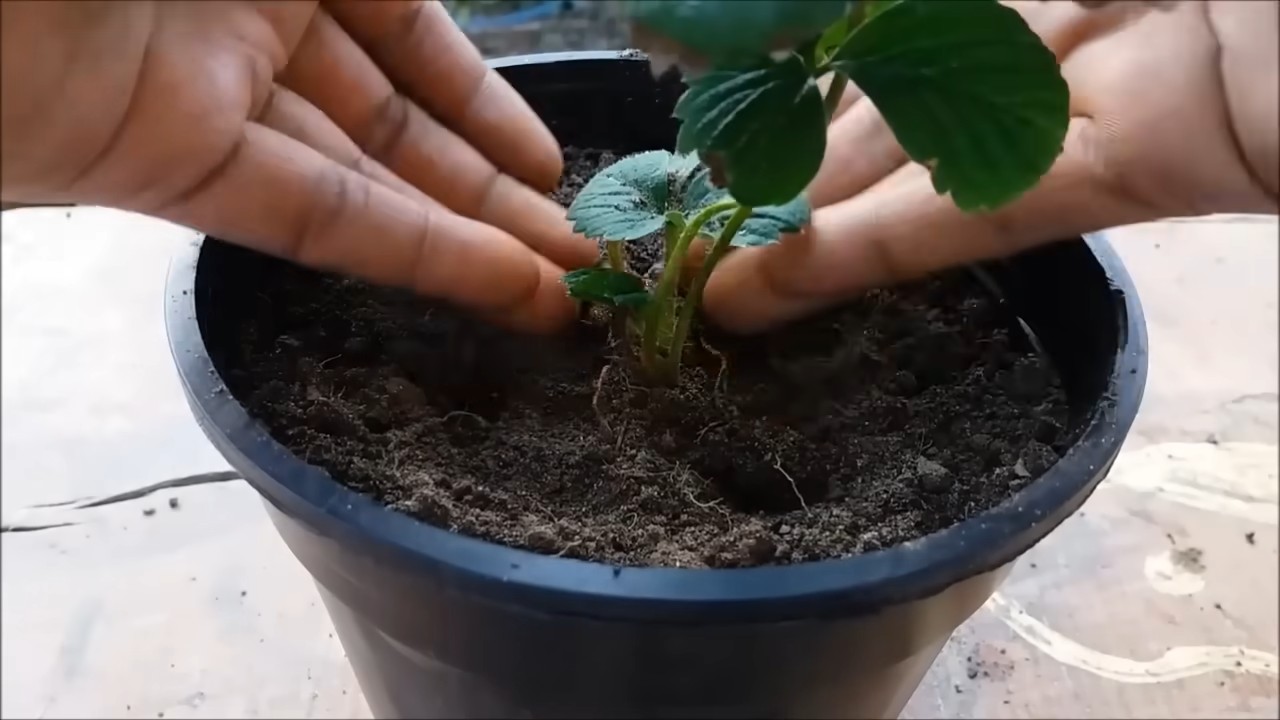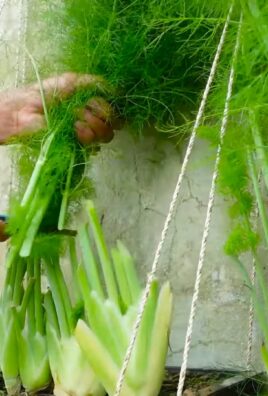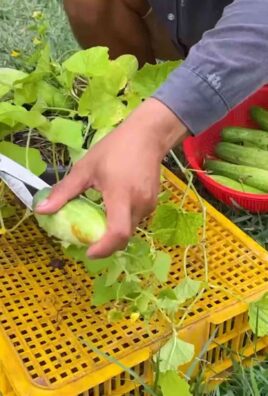Grow Strawberries Indoors? Absolutely! Imagine plucking juicy, sun-ripened strawberries right from your kitchen, even in the dead of winter. Sounds like a dream, right? Well, it’s a dream that can easily become a reality with a few simple DIY tricks. For centuries, humans have cultivated plants indoors, from the elaborate hanging gardens of Babylon to the humble windowsill herb gardens of today. But the desire to bring the bounty of the outdoors inside is more than just a trend; it’s a connection to nature, a source of fresh, healthy food, and a fantastic way to brighten up our living spaces.
In today’s busy world, finding the time and space for a traditional garden can be a challenge. That’s where the magic of indoor gardening comes in. And when it comes to delicious and rewarding plants, strawberries are a top contender. Learning how to grow strawberries indoors not only provides you with fresh, organic fruit, but it’s also a fun and educational project for the whole family. Plus, who can resist the sweet taste of a homegrown strawberry? So, let’s dive into some easy DIY hacks that will have you enjoying a strawberry harvest in no time!

Grow Your Own Delicious Strawberries Indoors: A Beginner’s Guide
Hey there, fellow plant enthusiasts! Ever dreamt of plucking fresh, juicy strawberries right from your own home, even when it’s snowing outside? Well, dream no more! Growing strawberries indoors is totally achievable, and I’m here to guide you through every step of the process. Get ready to enjoy the sweet taste of summer all year round!
Choosing the Right Strawberry Variety
Not all strawberry varieties are created equal, especially when it comes to indoor growing. You’ll want to pick everbearing or day-neutral varieties. These types produce fruit throughout the growing season, unlike June-bearing varieties that have one big harvest.
Here’s a quick rundown of some popular choices:
* Everbearing: These varieties produce two to three crops of strawberries per year – one in the spring, one in the summer, and sometimes one in the fall. They’re a great option for continuous harvesting. Examples include:
* Seascape: Known for its large, flavorful berries and good disease resistance.
* Albion: Another popular choice, producing sweet, conical-shaped berries.
* Ozark Beauty: A reliable everbearing variety with good flavor.
* Day-Neutral: These varieties produce fruit continuously throughout the growing season, regardless of the day length. They’re perfect for indoor growing where you can control the light. Examples include:
* Tristan: Produces beautiful pink flowers and delicious berries.
* San Andreas: Similar to Albion, with excellent flavor and productivity.
Pro Tip: Check your local garden center or online nurseries for varieties that are well-suited to your climate and growing conditions.
Gathering Your Supplies
Before we dive into the planting process, let’s make sure you have everything you need. Here’s a checklist:
* Strawberry Plants: You can start with bare-root plants, runners, or established plants from a nursery. I personally prefer starting with established plants because it gives me a head start.
* Pots or Containers: Choose pots that are at least 6-8 inches in diameter and have drainage holes. Hanging baskets are also a fun option!
* Potting Mix: Use a high-quality potting mix that’s well-draining and slightly acidic (pH 5.5-6.5). Avoid using garden soil, as it can compact and hinder drainage.
* Grow Lights: Strawberries need at least 6-8 hours of sunlight per day. If you don’t have a sunny window, invest in a good set of grow lights. LED grow lights are energy-efficient and work great.
* Watering Can or Spray Bottle: For gentle watering.
* Fertilizer: A balanced liquid fertilizer (10-10-10) formulated for strawberries.
* Optional:
* Pebbles or Gravel: To improve drainage in the bottom of the pots.
* Mulch: To help retain moisture and suppress weeds. Straw or pine needles work well.
* Hand Trowel: For planting.
* Pollinating Tool: A small paintbrush or cotton swab to hand-pollinate the flowers.
Planting Your Strawberries
Alright, let’s get our hands dirty! Here’s how to plant your strawberry plants:
1. Prepare the Pots: Fill your pots with potting mix, leaving about an inch of space at the top. If you’re using pebbles or gravel for drainage, add a layer to the bottom of the pot before adding the soil.
2. Plant the Strawberries: Gently remove the strawberry plant from its container. Loosen the roots slightly with your fingers. Dig a hole in the potting mix that’s large enough to accommodate the root ball. Place the plant in the hole, making sure the crown (the point where the stems meet the roots) is level with the soil surface.
3. Backfill and Water: Fill in the hole with potting mix, gently firming the soil around the plant. Water thoroughly until the water drains out of the bottom of the pot.
4. Mulch (Optional): Add a layer of mulch around the base of the plant to help retain moisture and suppress weeds.
Providing the Right Environment
Strawberries thrive in specific conditions. Here’s how to create the perfect indoor environment for them:
1. Light: Place your strawberry plants in a location that receives at least 6-8 hours of direct sunlight per day. If you don’t have enough natural light, use grow lights. Position the grow lights about 6-12 inches above the plants.
2. Temperature: Strawberries prefer temperatures between 60-80°F (15-27°C). Avoid placing them near drafts or heating vents.
3. Humidity: Strawberries like moderate humidity. If your indoor air is dry, you can increase the humidity by:
* Placing a tray of water near the plants.
* Using a humidifier.
* Misting the plants with water regularly.
4. Watering: Water your strawberry plants regularly, keeping the soil consistently moist but not soggy. Check the soil moisture by sticking your finger into the soil. If the top inch feels dry, it’s time to water. Avoid overwatering, as this can lead to root rot.
5. Fertilizing: Feed your strawberry plants with a balanced liquid fertilizer (10-10-10) every 2-4 weeks during the growing season. Follow the instructions on the fertilizer label.
Pollinating Your Strawberry Plants
Strawberries are self-pollinating, but they often need a little help, especially indoors where there are no bees or wind to do the job. Here’s how to hand-pollinate your strawberry flowers:
1. Use a Small Brush or Cotton Swab: Gently brush the pollen from the stamen (the part with the yellow pollen) of one flower onto the pistil (the central part) of another flower.
2. Repeat Regularly: Repeat this process every few days, especially when the flowers are open and receptive.
3. Observe: You’ll know pollination was successful when the base of the flower starts to swell and develop into a strawberry.
Dealing with Pests and Diseases
Even indoors, your strawberry plants can be susceptible to pests and diseases. Here’s how to prevent and treat common problems:
* Aphids: These tiny insects can suck the sap from your plants, causing them to weaken and distort. You can control aphids by:
* Spraying the plants with a strong stream of water.
* Using insecticidal soap.
* Introducing beneficial insects like ladybugs.
* Spider Mites: These tiny pests create webs on the plants and can cause the leaves to turn yellow and brown. You can control spider mites by:
* Increasing the humidity around the plants.
* Spraying the plants with insecticidal soap or neem oil.
* Powdery Mildew: This fungal disease causes a white, powdery coating on the leaves. You can prevent powdery mildew by:
* Providing good air circulation around the plants.
* Avoiding overhead watering.
* Using a fungicide if necessary.
* Root Rot: This fungal disease is caused by overwatering and poor drainage. You can prevent root rot by:
* Using well-draining potting mix.
* Watering only when the soil is dry to the touch.
* Ensuring your pots have drainage holes.
Important Note: Always follow the instructions on any pesticides or fungicides you use.
Harvesting Your Strawberries
The moment you’ve been waiting for! Here’s how to harvest your strawberries:
1. Wait for Ripeness: Strawberries are ready to harvest when they are fully red and slightly soft to the touch.
2. Gently Pick: Gently grasp the strawberry near the stem and twist or snip it off the plant.
3. Enjoy! Wash your strawberries and enjoy them fresh, or use them in your favorite recipes.
Encouraging Continued Production
To keep your strawberry plants producing fruit throughout the growing season, here are a few tips:
* Remove Runners: Strawberry plants produce runners (long stems that grow horizontally and develop new plantlets). If you want your plants to focus on fruit production, remove the runners as they appear. You can propagate the runners to create new strawberry plants if you wish.
* Prune Old Leaves: Remove any old, yellowing, or damaged leaves to encourage new growth and improve air circulation.
* Repot if Necessary: If your strawberry plants become root-bound (the roots are circling around the inside of the pot), repot them into a larger container.
* Dormancy Period: Some everbearing and day-neutral varieties benefit from a dormancy period during the winter. To induce

Conclusion
So, there you have it! Growing strawberries indoors might seem like a whimsical dream, but with a little know-how and dedication, it’s absolutely achievable. We’ve walked you through the essential steps, from selecting the right variety and providing adequate light to ensuring proper pollination and consistent watering. But why should you even bother with this DIY endeavor? The answer is simple: fresh, juicy, and intensely flavorful strawberries, grown right in your own home, regardless of the season. Imagine the delight of plucking a sun-ripened (or rather, grow-light-ripened!) berry in the dead of winter, a burst of summer sweetness amidst the cold.
Beyond the sheer pleasure of fresh strawberries, this project offers a unique connection to your food. You’ll gain a deeper understanding of the growing process, from seed to fruit, and experience the satisfaction of nurturing life with your own hands. Plus, it’s a fantastic way to introduce children to gardening and healthy eating habits.
But the benefits don’t stop there. Growing your own strawberries indoors is also a sustainable choice. You’ll reduce your reliance on commercially grown berries, which often travel long distances and may be treated with pesticides. You’ll also minimize packaging waste and contribute to a more eco-friendly lifestyle.
Now, let’s talk about variations. While we’ve focused on a general approach, there’s plenty of room for customization. Consider experimenting with different strawberry varieties to find your personal favorite. ‘Albion’ and ‘Seascape’ are popular choices for their everbearing qualities and delicious flavor, but don’t be afraid to branch out and try something new. You could also explore different growing mediums, such as hydroponics, for a more advanced and efficient system.
Another exciting variation is vertical gardening. If you’re short on space, consider using a vertical planter or hanging baskets to maximize your growing area. This not only saves space but also adds a touch of greenery to your home decor. You can even get creative with your lighting setup, using LED grow lights to supplement natural sunlight and ensure optimal growth.
Growing strawberries indoors is more than just a gardening project; it’s an experience. It’s a chance to connect with nature, cultivate your own food, and enjoy the simple pleasures of life. So, what are you waiting for? Gather your supplies, follow our guide, and embark on your indoor strawberry-growing adventure today!
We’re confident that you’ll be amazed by the results. And once you’ve harvested your first batch of homegrown strawberries, we encourage you to share your experience with us. Post photos of your plants, tell us about your successes and challenges, and let us know what you’ve learned along the way. Together, we can create a community of indoor strawberry growers and inspire others to embrace this rewarding hobby. Don’t forget to use the hashtag #IndoorStrawberries when you share your photos and stories on social media. We can’t wait to see your beautiful berries!
Frequently Asked Questions (FAQ)
What are the best strawberry varieties to grow indoors?
Choosing the right variety is crucial for indoor success. Everbearing varieties, which produce fruit throughout the growing season, are generally preferred. Some excellent choices include ‘Albion,’ ‘Seascape,’ ‘Tristan,’ and ‘Mara des Bois.’ These varieties are known for their flavor, productivity, and adaptability to indoor conditions. Day-neutral varieties are also a good option, as they are not dependent on day length for flowering and fruiting. Research each variety to understand its specific needs and choose one that aligns with your growing conditions and preferences. Consider factors like disease resistance, fruit size, and flavor profile when making your selection.
How much light do indoor strawberries need?
Light is arguably the most critical factor for successful indoor strawberry growing. Strawberries need at least 6-8 hours of direct sunlight per day. However, since natural sunlight can be limited indoors, especially during winter months, supplemental lighting is often necessary. LED grow lights are an excellent option, as they are energy-efficient and provide the full spectrum of light that plants need for photosynthesis. Position the grow lights about 6-12 inches above the plants and adjust the height as the plants grow. Monitor your plants closely for signs of insufficient light, such as leggy growth or pale leaves. If you notice these symptoms, increase the intensity or duration of the light.
How do I pollinate my indoor strawberry plants?
Pollination is essential for fruit production. Since there are no bees or other pollinators indoors, you’ll need to hand-pollinate your strawberry plants. This is a simple process that involves transferring pollen from the stamen (male part) to the pistil (female part) of the flower. You can use a small paintbrush, cotton swab, or even your finger to gently brush the pollen from one flower to another. Repeat this process every few days, especially when the flowers are newly opened. Another method is to gently shake the plants to release the pollen. You can also use a small fan to circulate air around the plants, which can help to distribute the pollen.
What type of soil is best for growing strawberries indoors?
Strawberries prefer well-draining, slightly acidic soil with a pH of 5.5 to 6.5. A good potting mix for strawberries should be light and airy, allowing for good root development. You can purchase a commercially available potting mix specifically formulated for fruits and vegetables, or you can create your own mix by combining equal parts of peat moss, perlite, and vermiculite. Avoid using garden soil, as it can be too heavy and may contain pests or diseases. Ensure that your containers have drainage holes to prevent waterlogging, which can lead to root rot.
How often should I water my indoor strawberry plants?
Watering frequency depends on several factors, including the size of the container, the type of soil, and the ambient temperature. Generally, you should water your strawberry plants when the top inch of soil feels dry to the touch. Avoid overwatering, as this can lead to root rot. Water deeply, ensuring that the water drains out of the drainage holes. During the growing season, you may need to water more frequently, especially if the plants are exposed to direct sunlight or grow lights. Check the soil moisture regularly and adjust your watering schedule accordingly.
How do I fertilize my indoor strawberry plants?
Strawberries are heavy feeders and require regular fertilization to produce abundant fruit. Use a balanced fertilizer specifically formulated for fruits and vegetables. Follow the instructions on the fertilizer label for application rates and frequency. You can use a liquid fertilizer or a slow-release granular fertilizer. Liquid fertilizers are typically applied every 2-4 weeks, while slow-release fertilizers can be applied every 2-3 months. Avoid over-fertilizing, as this can burn the roots and damage the plants. Monitor your plants for signs of nutrient deficiencies, such as yellowing leaves or stunted growth.
How do I deal with pests and diseases on my indoor strawberry plants?
Indoor strawberry plants are generally less susceptible to pests and diseases than outdoor plants. However, they can still be affected by common pests such as aphids, spider mites, and whiteflies. Regularly inspect your plants for signs of infestation, such as webbing, sticky residue, or distorted leaves. If you detect pests, you can try to remove them manually by wiping the leaves with a damp cloth or spraying the plants with a strong stream of water. You can also use insecticidal soap or neem oil to control pests. For fungal diseases, such as powdery mildew, ensure good air circulation and avoid overwatering. You can also use a fungicide if necessary.
How long does it take for indoor strawberries to produce fruit?
The time it takes for indoor strawberries to produce fruit depends on the variety, growing conditions, and the age of the plants. Generally, you can expect to harvest your first strawberries within 2-3 months of planting. Everbearing varieties will continue to produce fruit throughout the growing season, while June-bearing varieties will produce a single large crop. Be patient and provide your plants with the proper care, and you’ll be rewarded with delicious, homegrown strawberries in no time.
Can I grow strawberries from seed indoors?
Yes, you can grow strawberries from seed indoors, but it requires more patience and effort than starting with established plants. Strawberry seeds need a period of cold stratification (exposure to cold temperatures) to germinate properly. You can achieve this by placing the seeds in the refrigerator for 4-6 weeks before planting. Sow the seeds in a seed-starting mix and keep them moist but not waterlogged. Germination can take several weeks. Once the seedlings are large enough to handle, transplant them into individual pots.
How do I overwinter my indoor strawberry plants?
Even though you are growing indoors, your strawberry plants will benefit from a dormant period. Reduce watering and stop fertilizing in the late fall. Move the plants to a cooler location (around 40-50°F) with less light for a few months. This allows the plants to rest and conserve energy for the next growing season. In the early spring, gradually increase watering and light exposure. Once new growth appears, resume fertilizing.




Leave a Comment